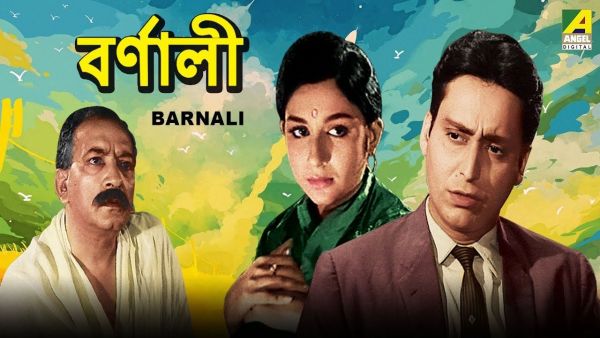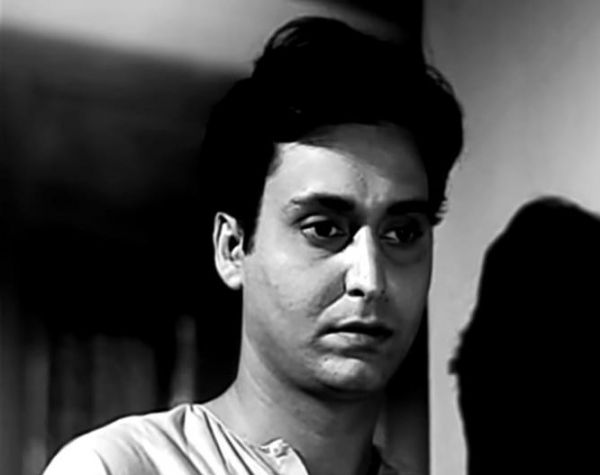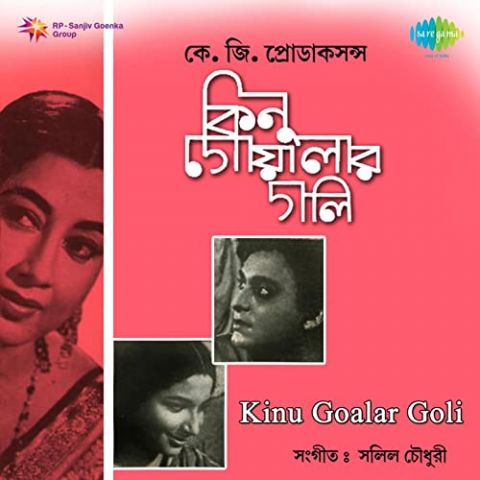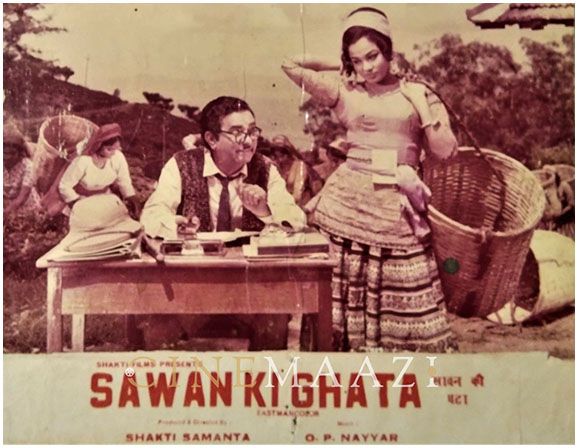Sharmila Tagore: From Kolkata to Kashmir
Though Satyajit Ray’s Apur Sansar and Devi are by far the most well-known collaborations Sharmila Tagore had with Soumitra Chatterjee, she acted in two more films with the latter before moving on to carve out a career in Hindi cinema. On the legend’s birthday, Cinemaazi editor Shantanu Ray Chaudhuri looks at these lesser-heralded films Kinu Goalar Goli and Barnali…
For anyone initiated into cinema by none other than Satyajit Ray, in films that were hailed instant international classics, to venture into Hindi cinema with a Shammi Kapoor starrer was by any reckoning a leap of faith unlike any. But as Sharmila Tagore has often maintained, quoting from the Frank Sinatra song, she always did things her way, with nary a thought for conventional wisdom.
Before leaving Apu’s world behind and going on to become the much-loved Kashmir Ki Kali, she was an integral part of two more films with Soumitra Chatterjee, which in some ways feed off and recall their more celebrated work together in the Ray films.
Of the two, it isn’t surprising that Barnali (1963) feels a more accomplished work, given that it has Ajoy Kar helming it. Starting out as a cinematographer at Indrapuri Studios in 1938, he shot a number of films, venturing out as a director in 1949 with Ananya (made by the film collective founded by Kanan Devi, Sabyasachi). By the time he made Barnali, Kar was a major name in mainstream Bengali cinema, having directed two seminal Uttam Kumar-Suchitra Sen films, Harano Sur and Saptapadi, as also Saat Pake Badha, another definitive film of the era boasting what many consider one of Suchitra Sen’s finest performances. Even if Barnali never scales the creative highs of these films, it remains an eminently watchable one – thanks primarily to its two winsome lead performances, some exquisite black and white cinematography (Bishu Chakraborty) and Kartik Bose’s innovative art direction.

Trideep Sarkar (Kamal Mitra, imperious as an insufferable snob), who is in the middle of his daughter’s wedding arrangements, assigns his nephew Ashesh (Soumitra Chatterjee) the task of distributing wedding cards. So conscious Trideep is of social standing that the invites are being rationed by the class and usefulness of the invitee. As such, when Ashesh arrives at schoolteacher Biman Chaudhuri’s (Pahadi Sanyal) house, the latter finds it hard to believe that Trideep would invite him and his family. But being the quintessential good man who believes in the inherent goodness of people, he accepts the invite – though Ashesh discovers that he has forgotten to bring the card. Needless to say, it turns out that Ashesh had the wrong address and a livid Trideep, who will not have someone of ‘no consequence’ at the wedding, insists that he go back to tell Biman Chaudhuri that the invitation is a mistake.
Not enamoured of his uncle’s uncouthness, Ashesh nevertheless goes back to perform the distasteful task – thus setting the stage for a relationship between him and Biman Chaudhuri’s young daughter Aloka (Sharmila Tagore). Aloka, of course, is not as unforgiving in her acceptance of his uncle’s snobbery but gradually lets her guard down in the face of Ashesh’s genuine regret and sensitivity. Ashesh soon has more on his plate as he discovers that the man his cousin is marrying, a young scholar named Saileshwar Ghosh (N. Viswanathan), has reneged on a promise to marry Aloka without even telling her.
Things take an unexpected turn at the wedding venue (what a delight it is to hear the wedding band play the theme from Bridge on the River Kwai) when Trideep’s boss Mr Mukherjee (Haradhan Banerjee) mentions wanting to meet Biman Chaudhuri whom he knows and admires. Trideep perforce has to go and fetch the Chaudhuris. Thus begins Ashesh’s new ordeal as he strives to keep Aloka away from discovering Saileshwar as the groom. Towards this end, he cajoles her to accompany him to his house, leading to the film’s most captivating part.
Aloka: We have been walking for half an hour without a taxi in sight – you sure are a bad omen!
Ashesh: Only recently you seemed to be willing to walk to the end of the world with me.
…
Aloka: We have to go somewhere – where do you think?
Ashesh: Je dike mon chaye. (Wherever the heart desires.)
Aloka: Mon jodi bole nirruddeshe jabo? (What if the heart wants to go around aimlessly?)
Ashesh: Besh toh! Tahole tai jawa jaabe. (Perfect! That too can be arranged.)
ASHESH HAILS A TAXI.
Ashesh: Cholun. (Come, let’s go.)
Aloka: E ki. Kothai jabo? (What’s this, where do we go?)
Ashesh: Ei je bollen nirruddeshe jaben. (Why! You are the one who mentioned going on aimlessly.)
It is not difficult to recall Apur Sansar, such is the chemistry between the two that animates the entire sequence. One cannot but fall in love with the way Aloka and Ashesh come to understand each other, in the process helping us understand how their relationship has evolved in the span of a few hours. Aloka has much more agency than Aparna or Doyamoyee has in Apur Sansar and Devi respectively. She is pursuing a BA in philosophy, has to contend with a myriad range of discoveries about herself and people around her – and Sharmila Tagore is simply fabulous in a role that requires her to convey how she is making sense of the character’s drives and motivations, and coming to terms with the realization that she is falling in love with Ashesh (beautifully conveyed in a later scene where they go for a boat ride on the Ganga, to the accompaniment of Rabindranath Tagore’s ‘Jokhon bhanglo milan mela’ even as the light reflects off the water on to her expressive face suffused with her inner struggle).
.jpeg/WhatsApp%20Image%202020-12-08%20at%2012_32_43%20PM%20(1)__600x471.jpeg)

Sharmila Tagore on Barnali:
I did Apur Sansar and Devi when I was still in school and both were done without a formal remuneration – I did not consider myself a professional actor. Of course, Manik-da would compensate me with gifts – a sari, a watch… The films were shot during my holidays. Then my father was transferred to Madras and I continued my studies there, finishing my Senior Cambridge two years later. I returned to Calcutta and joined Loreto House. There was still a lot of interest in me because of Apur Sansar and Devi, so my parents were getting a lot of enquiries. One was Haridas Bhattacharya’s Sesh Anka with Uttam Kumar which my parents accepted – and that was when I became a professional actor, I was paid a remuneration. I saw the film recently and I was quite impressed with my performance. Maybe I watched it without being overly critical knowing that it was my first film outside of Manik-da’s and as an actor who had not been taught the craft of acting. I was extremely natural and in no way daunted by Uttam Kumar’s presence.
It was during this time that I shot a few films with Soumitra, including Barnali and Kinu. I had started shooting for Kashmir Ki Kali in 1963. Of these, I remember Barnali clearly … these black and white films fascinate me and because Ajoy Kar had been a cinematographer, the camerawork in Barnali was outstanding – even on YouTube you can see the chiaroscuro effect, the play of light and shade, each frame so lovingly crafted. There was a rain scene, if you remember … it was a triumph of set design … a taxi arriving, waiting, and Soumitra and I keep bantering away … and you can’t actually tell that it’s not outdoor/indoor … that it’s all part of a set, beautifully done. The art direction creating the house I lived in was also so realistic – it is how houses were in those narrow by-lanes of Calcutta those days. Soumitra standing at the window and watching me poring over my books.
Beautiful sequences … the taxi ride through the city at night … The scene next to the Ganga ghat and on a whim they go on a boat ride. The whole thing keeps you engrossed. The way the narrative unfolds and their personalities unfold. And then the understated manner in which she realizes that the groom is someone she is engaged to. Each character is so well-etched in the matter of those few hours over which the narrative develops: Pahadi Sanyal, so otherworldly in his demeanour, the groom who has his own reasons, Soumitra, who never tries to influence my character … he just can’t bring himself to tell her truth lest it hurts her. The sensibilities are so modern for the times.
What Kinu Goalar Goli, which came a year later, lacks in terms of the technical finesse and flow of Barnali, it compensates for with certain psychological aspects in its narrative. A more innovative film-maker would probably have explored this aspect of the film in greater detail, giving the film more heft than it has. O.C. Ganguly – there’s little information available on him, with almost all sources crediting him with only this as his sole directorial credit – unfortunately opts for a surface exploration of the psychology of the film’s protagonists, focusing more on the domestic conflict and its resolution. Still, the film, based on a story by Santosh Kumar Ghosh, offers enough – particularly in terms of the performances, a couple of Salil Chowdhury gems shot on Sharmila Tagore and superlative art direction by Rabi Chattopadhyay – to satisfy a viewer interested in a largely forgotten vehicle starring some of big names of Bengali cinema at the time. (Interestingly, when the film was first announced in 1960, it was supposed to star Uttam Kumar, Arundhati Devi and Chhabi Biswas, with music by Rabin Chatterjee.)

We are introduced to Neera’s family and discover that they have fallen on bad times after her father’s (Pahadi Sanyal) misadventures in the stock market. We are also made privy to the family dynamics, involving an ailing mother, a meek elder brother and his shrewish wife (played by Gita Dey). There’s her sister-in-law’s elderly uncle, Kakababu (Jiben Bose), who has his eyes on her – asking her to sing a song (Sabita Chowdhury’s delectable ‘Dokhina batash mon keno’) and promising to bring her a radio the next time he visits – which he does, never mind that his attentions are unwelcome and the father disapproves of the gift.
It is through Neera that we meet the film’s chief protagonists – Shanti (Sumitra Devi) and her writer husband Mani (Kali Banerjee). And at the first meeting itself, at the threshold of the ramshackle communal washroom so typical of these houses of the era, Shanti is enigmatic: ‘Naam ta shudhu namei aache.’ (The name – Shanti, peace – exists only in name.)
It transpires that Shanti’s husband is a struggling writer and they can barely make ends meet. However, interestingly, as she says, they never cook at home and food always comes from a ‘hotel’ nearby. Mani appears too indolent to perform any household chores. Even more intriguingly, it is clear that he encourages her, in fact pushes her towards his men friends. To what end is never made clear, though she is shown engaging in card games with his friends in a haze of cigarette smoke. A deeply unhappy Shanti – aspiring for the everyday joys of domesticity – hits on the ploy of trying to arouse Mani’s jealousy by feigning an affair with one of the regular men friends who visit, Indrajit (Soumitra Chatterjee).
Indrajit is a budding poet and it is at Shanti and Mani’s that Neera first meets him. Equally impoverished, Indrajit manages to get a job as a proof-reader at a publishing house at a salary of Rs 70 though he can barely countenance the state of modern literature and the quality of books he has to work on. (Apu’s first job in Apur Sansar was at a printing press – and like Apu, Indrajit is inclined towards literature and has no family of his own, as Shanti tells Neera: Ore keu nei – he has no one else).
Though Indrajit addresses Shanti as ‘Shanti boudi’, in a telling scene she asks him why he cannot call her just by her name, without the ‘boudi’. She also borrows money from him – in fact, he has no qualms in handing over his wallet to her. She also invites him on outings on rain-drenched monsoon days in a sequence shot beautifully to the strains of Sandhya Mukherjee’s ‘Shrabon ajhar jhore’.
When they return, Mani is busy writing, but suddenly pretends to be asleep as she enters the room. Later, serving her husband dinner, she describes her day with Indrajit in detail. It is not apparent if Shanti is successful in her ploy. However, at a dress-rehearsal for a play he has written, Shanti realizes that he has been putting all his experiences into the play, including her request to Indrajit to call her by name – to which Mani has been privy.
If the build-up till now is quite interesting – and offers avenues to explore – the script opts for a deus ex machina. Shanti turns up as an actor, Chitrangada Devi, cast in a film written by Mani, even proceeding to make the point that the story might have to be rewritten keeping in her demands as the star. This proves too much for Mani and leads to the long-awaited confrontation between husband and wife and the ultimate reconciliation – whereby they come to the conclusion that in order for them to have any chance at happiness, he as a writer, she as a homemaker, they have to leave the accursed street.
And how uplifting it is to hear Soumitra Chatterjee recite lines from William Ernest Henley’s ‘Invictus’: I am the master of my fate. I am the captain of my soul. In probably the strongest sequence involving the two, Indrajit looks at a portrait of Van Gogh hanging on the wall (another aspect of the film that one would have liked to see more of) and quotes the legendary artist: ‘Dying is hard, but living is harder still.’ No surprise then that the film ends with Neera and Indrajit in the empty room, just vacated by Shanti and Mani – minutes after the couple had announced, ‘Ekhane manush bachena’ (it is impossible to survive here) only for Indrajit to respond: ‘But can you say that without at least trying?’
Given that neither Apur Sansar nor Devi gave their leads a stab at happiness – Aparna passing away at childbirth, Doyamoyee falling prey to blind superstition – it is tempting to wonder if the worlds of Barnali and Kinu Goalar Goli are what Apu-Aparna or Doya-Umaprasad would have had if fates had dealt them a better hand. Sharmila Tagore moved to the world of Hindi films, becoming not only the biggest star of the era, but also the one truly successful crossover actor from Bengali cinema in Bombay, defining fashion and stardom in a way that being rooted in Bengal would probably not have allowed her.
Tags
About the Author
Shantanu Ray Chaudhuri is either an 'accidental' editor who strayed into publishing from a career in finance and accounts or an 'accidental' finance person who found his calling in publishing. He studied commerce and after about a decade in finance and accounts, he left it for good. He did a course in film, television and journalism from the Xavier's Institute of Mass Communication, Mumbai, after which he launched a film magazine of his own called Lights Camera Action. As executive editor at HarperCollins Publishers India, he helped launch what came to be regarded as the go-to cinema, music and culture list in Indian publishing. Books commissioned and edited by him have won the National Award for Best Book on Cinema and the MAMI (Mumbai Academy of Moving Images) Award for Best Writing on Cinema. He also commissioned and edited some of India's leading authors like Gulzar, Manu Joseph, Kiran Nagarkar, Arun Shourie and worked out co-pub arrangements with the Society for the Preservation of Satyajit Ray Archives, apart from publishing a number of first-time authors in cinema whose books went on to become best-sellers. In 2017, he was named Editor of the Year by the apex publishing body, Publishing Next. He has been a regular contributor to Anupama Chopra's online magazine Film Companion. He is also a published author, with two books to his credit: Whims – A Book of Poems (published by Writers Workshop) and Icons from Bollywood (published by Penguin Books).








.jpg)


